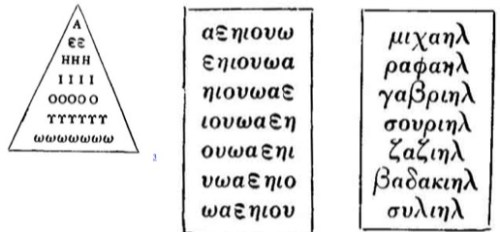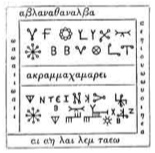The Name of God is Woven Throughout the Torah
“This also explains the particular character of the Torah, which is designed to show the way to the worship of God under the specific conditions of this aeon. The present aeon is ruled by the evil inclination that stems from the power of Stern Judgment and that seduces man to idolatry, which had no place during the preceding period.
At present, the Torah aims to conquer the power of evil, and that is why it contains commandments and prohibitions, things permitted, things forbidden, the pure and the impure. Only a few souls, originating in the preceding aeon, return in order to preserve the world through the power of grace and to temper the destructive sternness of judgment.
Among them are Enoch, Abraham, and Moses. At present, even the perfectly righteous must enter into the bodies of animals; this is the secret reason for the special prescriptions relating to ritual slaughter.
The doctrine of the passage of the souls into the bodies of animals appears here for the first time in kabbalistic literature; it may reflect a direct contact with Cathar ideas (as suggested on p. 238) and serve to support the argument for the Provençal origin of the Temunah.
But among the Cathars as also in India this doctrine led to vegetarianism whereas here, on the contrary, it led to a more meticulous observance of the prescriptions concerning the consumption of meat; the slaughtering of an animal and the eating of its flesh are related to the elevation of the soul confined there from an animal to a human existence.
A distinct concept of hell, which would compete with the notion of the transmigration of souls, seems to be outside the purview of our author. For the rest, the book deals with this doctrine only with great reserve, in spite of its almost unlimited validity; the old commentary, printed together with the editions of the text, was to be much less discreet.
The author even knew that in the present aeon the letters of the Torah had refused to assemble themselves into the particular combinations that would compose the form in which it was to be given to Israel at Sinai.
They saw the law of Stern Judgment and how this shemittah is entangled and ensnared in evil, and they did not wish to descend into the filth upon which the palace of this aeon was erected. But “God arranged with them that the great and glorious name would be combined with them and would be contained in the Torah.”243
Apparently this signifies more than the direct mention of the name of God in the Torah. Rather, the name of God is contained everywhere in the Torah, in a mystical mode; as ibn Gikatilla put it: “It is woven into” the Torah.
All the laws and mysteries of this aeon are inscribed in secret language in this Torah, which embraces all ten sefiroth, and all this is indicated by the particular form of the letters. “No angel can understand them, but only God Himself, who explained them to Moses and communicated to him their entire mystery” (fol. 30a).
On the basis of these instructions, Moses wrote the Torah in his own language, organizing it, however, in a mystical spirit that conformed to these secret causalities. The present aeon must obey this law of Stern Judgment and the Torah that corresponds to it, and only at its end will all things return to their original state.
The author proceeds from the assumption that there also exists within the shemittah an internal cyclical system. The human race, born from the one Adam, developed into millions of individuals. After the redemption, which will take place in the sixth millenium, humanity will perish in the same rhythm in which it began. “In the manner in which everything came, everything passes away.” “The doors to the street are shut” (Eccles. 12:4), and everything returns home to its origin, even the angels of the Merkabah corresponding to this aeon, the heavenly spheres, and the stars.”
Gershom Scholem, Origins of the Kabbalah, 1962, pp. 468-9.



